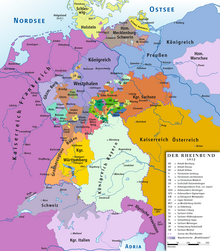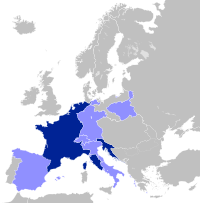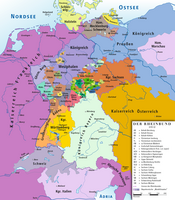Confederation of the Rhine: Difference between revisions
mNo edit summary |
Rescuing 1 sources and tagging 0 as dead. #IABot (v1.5beta) (Mr. Guye) |
||
| Line 70: | Line 70: | ||
==Member monarchies== |
==Member monarchies== |
||
The following table shows the members of the confederation, with their date of joining, as well as the number of troops provided, listed in parentheses.<ref>[http://195.154.144.20/en/Template/chronologie.asp?idpage=464577&onglet=1 Creation of the Confederation of the Rhine, 12 July, 1806]</ref> |
The following table shows the members of the confederation, with their date of joining, as well as the number of troops provided, listed in parentheses.<ref>[http://195.154.144.20/en/Template/chronologie.asp?idpage=464577&onglet=1 Creation of the Confederation of the Rhine, 12 July, 1806] {{webarchive|url=https://archive.is/20110529142612/http://195.154.144.20/en/Template/chronologie.asp?idpage=464577&onglet=1 |date=29 May 2011 }}</ref> |
||
{{History_of_Germany}} |
{{History_of_Germany}} |
||
[[File:Rheinbund 1806, political map.png|thumb|right|Member states of the Confederation of the Rhine, 1806.]] |
[[File:Rheinbund 1806, political map.png|thumb|right|Member states of the Confederation of the Rhine, 1806.]] |
||
Revision as of 00:44, 28 July 2017
This article needs additional citations for verification. (July 2014) |
Confederated States of the Rhine Confederation of the Rhine | |||||||||
|---|---|---|---|---|---|---|---|---|---|
| 1806–1813 | |||||||||
 The Confederation of the Rhine in 1812 | |||||||||
| Status | Confederation of client states of the French Empire | ||||||||
| Capital | Frankfurt | ||||||||
| Common languages | German, French | ||||||||
| Religion | Roman Catholicism Protestantism | ||||||||
| Protector | |||||||||
• 1806–13 | Napoleon I | ||||||||
| Prince-Primate | |||||||||
• 1806–13 | Karl von Dalberg | ||||||||
• 1813 | Eugène de Beauharnais | ||||||||
| Legislature | Diet of the Confederation | ||||||||
| Historical era | Napoleonic Wars | ||||||||
• Treaty of the Confederation of the Rhine | 12 July 1806 | ||||||||
• Holy Roman Empire dissolved | 6 August 1806 | ||||||||
| 4 November 1813 | |||||||||
| |||||||||
| Today part of | |||||||||
The Confederation of the Rhine (German: Rheinbund; French: officially États confédérés du Rhin ["Confederated States of the Rhine"], but in practice Confédération du Rhin) was a confederation of client states of the First French Empire. It was formed initially from 16 German states by Napoleon after he defeated Austria and Russia at the Battle of Austerlitz. The Treaty of Pressburg, in effect, led to the creation of the Confederation of the Rhine. It lasted from 1806 to 1813.[1]
The members of the confederation were German princes (Fürsten) from the Holy Roman Empire. They were later joined by 19 others, all together ruling a total of over 15 million subjects providing a significant strategic advantage to the French Empire on its eastern front. Prussia and Austria were not members.
Napoleon sought to consolidate the modernizing achievements of the revolution, but he wanted the soldiers and supplies these subject states could provide for his wars. Napoleon required it to supply 63,000 troops to his army. The success of the Confederation depended on Napoleon's success in battle; it collapsed when he lost the Battle of Leipzig in 1813.
Formation
On 12 July 1806, on signing the Treaty of the Confederation of the Rhine (German: Rheinbundakte) in Paris, 16 states in present-day Germany joined together in a confederation (the treaty called it the états confédérés du Rhinelande, with a precursor in the League of the Rhine).[2] Napoleon was its "protector". On 1 August, the members of the confederation formally seceded from the Holy Roman Empire, and on 6 August, following an ultimatum by Napoleon, Francis II declared the Holy Roman Empire dissolved. Francis and his Habsburg dynasty continued as emperors of Austria.
According to the treaty, the confederation was to be run by common constitutional bodies, but the individual states (in particular the larger ones) wanted unlimited sovereignty.[1] Instead of a monarchical head of state, as the Holy Roman Emperor had had, its highest office was held by Karl Theodor von Dalberg, the former Arch Chancellor, who now bore the title of a Prince-Primate of the confederation. As such, he was President of the College of Kings and presided over the Diet of the Confederation, designed to be a parliament-like body although it never actually assembled.[1] The President of the Council of the Princes was the Prince of Nassau-Usingen.
In return for their support of Napoleon, some rulers were given higher statuses: Baden, Hesse, Cleves, and Berg were made into grand duchies, and Württemberg and Bavaria became kingdoms. States were also made larger by incorporating the many smaller "Kleinstaaten", or small former imperial member states. They had to pay a very high price for their new status, however. The Confederation was above all a military alliance: the members had to maintain substantial armies for mutual defense and supply France with large numbers of military personnel. As events played out the members of the confederation found themselves more subordinated to Napoleon than they had been to the Habsburgs.[3]
After Prussia lost to France in 1806, Napoleon cajoled most of the secondary states of Germany into the Confederation of the Rhine. Eventually, an additional 23 German states joined the Confederation. It was at its largest in 1808, when it included 36 states—four kingdoms, five grand duchies, 13 duchies, seventeen principalities, and the Free Hansa towns of Hamburg, Lübeck, and Bremen.[1] Only Austria, Prussia, Danish Holstein, and Swedish Pomerania stayed outside, not counting the west bank of the Rhine and the Principality of Erfurt, which were annexed by the French empire.
In 1810 large parts of what is now northwest Germany were quickly annexed to France in order to better monitor the trade embargo with Great Britain, the Continental System.
The Confederation of the Rhine collapsed in 1813, in the aftermath of Napoleon's failed campaign against the Russian Empire. Many of its members changed sides after the Battle of Leipzig, when it became apparent Napoleon would lose the War of the Sixth Coalition.
Member monarchies
The following table shows the members of the confederation, with their date of joining, as well as the number of troops provided, listed in parentheses.[4]
| History of Germany |
|---|
 |



College of Kings
| Flag | Member monarchy | Year joined | Notes |
|---|---|---|---|
| Grand Duchy of Baden | 12 Jul 1806 | Co-founder; former margraviate (8,000) | |
| Kingdom of Bavaria | 12 Jul 1806 | Co-founder; former duchy (30,000) | |
| Grand Duchy of Berg | 12 Jul 1806 | Co-founder; absorbed Cleves, both formerly Duchies (5,000) | |
| Grand Duchy of Hesse-Darmstadt | 12 Jul 1806 | Co-founder; former landgraviate (4,000) | |
| Principality of Regensburg | 12 Jul 1806 | Co-founder; formerly Prince-Archbishopric and Electorate; after 1810 the | |
| Kingdom of Saxony | 11 Dec 1806 | Former electorate (20,000) | |
| Kingdom of Westphalia | 15 Nov 1807 | Napoleonic creation (25,000) | |
| Kingdom of Württemberg | 12 Jul 1806 | Co-founder; former duchy (12,000) | |
| Grand Duchy of Würzburg | 23 Sep 1806 | Napoleonic creation (2,000) |
College of Princes
| Flag | Member monarchy | Year joined | Notes |
|---|---|---|---|
| Duchy of Anhalt-Bernburg | 11 Apr 1807 | (700) | |
| Duchy of Anhalt-Dessau | 11 Apr 1807 | (700) | |
| Duchy of Anhalt-Köthen | 11 Apr 1807 | (700) | |
| Duchy of Arenberg | 12 Jul 1806 | Co-founder; mediatized 13 December 1810 (379 of 4,000) | |
| Principality of Hohenzollern-Hechingen | 12 Jul 1806 | Co-founder (97 of 4,000) | |
| Principality of Hohenzollern-Sigmaringen | 12 Jul 1806 | Co-founder (193 of 4,000) | |
| Principality of Isenburg | 12 Jul 1806 | Co-founder (291 of 4,000) | |
| Principality of Leyen | 12 Jul 1806 | Co-founder; former countship or graviate (29 of 4,000) | |
| Principality of Liechtenstein | 12 Jul 1806 | Co-founder (40 of 4,000) | |
| Principality of Lippe-Detmold | 11 Apr 1807 | (650) | |
| Duchy of Mecklenburg-Schwerin | 22 Mar 1808 | (1,900) | |
| Duchy of Mecklenburg-Strelitz | 18 Feb 1808 | (400) | |
| Duchy of Nassau (Usingen and Weilburg) | 12 Jul 1806* | Union of | |
| Duchy of Oldenburg | 14 Oct 1808 | annexed by France 13 December 1810 (800) | |
| Principality of Reuss-Ebersdorf | 11 Apr 1807 | (400) | |
| Principality of Reuss-Greiz | 11 Apr 1807 | (400) | |
| Principality of Reuss-Lobenstein | 11 Apr 1807 | (400) | |
| Principality of Reuss-Schleiz | 11 Apr 1807 | (400) | |
| Principality of Salm (Salm-Salm and Salm-Kyrburg) | 25 Jul 1806 | Co-founder; annexed by France 13 December 1810 (323 of 4,000) | |
| Duchy of Saxe-Coburg | 15 Dec 1806 | (Saxon duchies total 2,000) | |
| Duchy of Saxe-Gotha | 15 Dec 1806 | ||
| Duchy of Saxe-Hildburghausen | 15 Dec 1806 | ||
| Duchy of Saxe-Meiningen | 15 Dec 1806 | ||
| Duchy of Saxe-Weimar | 15 Dec 1806 | ||
| Principality of Schaumburg-Lippe | 11 Apr 1807 | (650) | |
| Principality of Schwarzburg-Rudolstadt | 11 Apr 1807 | (650) | |
| Principality of Schwarzburg-Sondershausen | 11 Apr 1807 | (650) | |
| Principality of Waldeck-Pyrmont | 11 Apr 1807 | (400) |
Aftermath
The allies opposing Napoleon dissolved the Confederation of the Rhine on 4 November 1813. After its demise, the only attempt at political coordination in Germany until the creation on 8 June 1815 of the German Confederation was a body called the Central Administration Council (German: Zentralverwaltungsrat); its President was Heinrich Friedrich Karl Reichsfreiherr vom und zum Stein (1757–1831). It was dissolved on 20 June 1815.
On 30 May 1814 the Treaty of Paris declared the German states independent.
In 1814-1815, the Congress of Vienna redrew the continent's political map. Napoleonic creations such as the huge Kingdom of Westphalia, the Grand Duchy of Berg and the Duchy of Würzburg were abolished; suppressed states, including Hanover, the Brunswick duchies, Hesse-Kassel and Oldenburg, were reinstated. On the other hand, most members of the Confederation of the Rhine located in central and southern Germany survived with minor border changes. They, along with the reinstated states, Prussia and Austria formed the German Confederation.
See also
- League of the Rhine
- History of Germany
- West Germany
- List of German monarchs
- List of French possessions and colonies
References
- ^ a b c d Hans A. Schmitt. Germany Without Prussia: A Closer Look at the Confederation of the Rhine. German Studies Review 6, No. 4 (1983), pp 9-39.
- ^ For the treaty (in French), see here
- ^ Germany at Encyclopædia Britannica
- ^ Creation of the Confederation of the Rhine, 12 July, 1806 Archived 29 May 2011 at archive.today
Sources and external links
- English translation of the treaty establishing the Confederation of the Rhine
- French version of the treaty establishing the Confederation of the Rhine
- Confederation of the Rhine on Napoleon Guide.com
- Confederation of the Rhine on World Statesmen.org
50°07′N 8°41′E / 50.117°N 8.683°E




